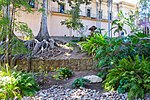Balboa Park (San Diego)

Balboa Park is a 1,200-acre (4.9 km2) historic urban cultural park in San Diego, California, United States. In addition to open space areas, natural vegetation zones, green belts, gardens, and walking paths, it contains museums, several theaters, and the San Diego Zoo. There are also many recreational facilities and several gift shops and restaurants within the boundaries of the park. Placed in reserve in 1835, the park's site is one of the oldest in the United States dedicated to public recreational use. Balboa Park is managed and maintained by the Parks and Recreation Department of the City of San Diego. Balboa Park hosted the 1915–16 Panama–California Exposition and 1935–36 California Pacific International Exposition, both of which left architectural landmarks. The park and its historic Exposition buildings were declared a National Historic Landmark and National Historic Landmark District in 1977, and placed on the National Register of Historic Places.
Excerpt from the Wikipedia article Balboa Park (San Diego) (License: CC BY-SA 3.0, Authors, Images).Balboa Park (San Diego)
Park Boulevard, San Diego
Geographical coordinates (GPS) Address Nearby Places Show on map
Geographical coordinates (GPS)
| Latitude | Longitude |
|---|---|
| N 32.731388888889 ° | E -117.14527777778 ° |
Address
Inez Grant Parker Memorial Rose Garden
Park Boulevard
92134 San Diego
California, United States
Open on Google Maps










